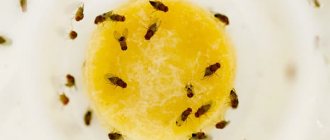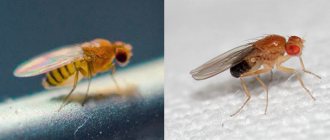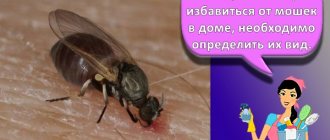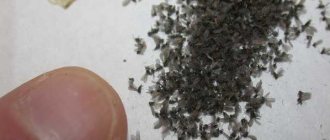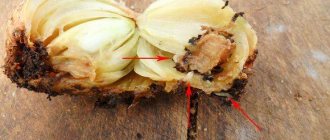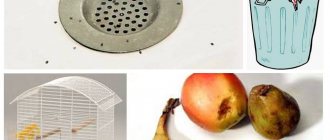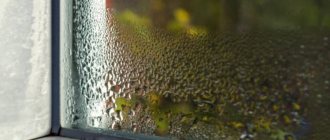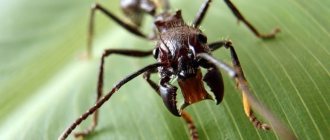How many midges live in apartments? What types of midges can live in residential premises. How does infection with these insects occur? Appearance of different types of midges. Diet, stages of development, reproduction. What you need to know about midges to quickly and permanently get rid of them.
If a small annoying midge appears in the apartment, it means there is something in the room that attracts it. It could be rotten, spoiled fruits, berries, vegetables, or there may be high humidity in the apartment, or perhaps there is mold.
There may actually be many reasons, but it is worth remembering that in the fight against these insects it is very important to eliminate all possible factors that attract them. Next, we will look at these insects in more detail, find out how long midges live, what species can appear in an apartment, what they look like, and their diet.
Varieties
Experts classify varieties of midges depending on their habitat and favorite foods of insects:
- Sewer flies. They fly out of sewer pipes and sinks. Outwardly it may seem that they are “fluffy”. The inhabitants of shells are often called black midges for their dark color.
- Fungus small mosquitoes. These annoying creatures rummage through indoor flowers, causing damage to the soil.
- Clothes or food moth. Accordingly, the first lives in the wardrobe, and the second in the kitchen cabinets. These are real pests that cause serious damage.
- Nasty. These are very annoying midges that bite and try to fly into your eyes. The main thing is not to confuse them with mosquitoes.
- Drosophila are fruit flies or fruit flies. These are the safest insects when compared to those listed above, but they multiply quickly and can cause significant discomfort.
Attention! Fruit midges are dozens of species of insects that are practically indistinguishable in appearance. The average size of one individual is 1-3 mm, and you can recognize it by its “drunk” slow flight and oval body shape
The insect's body color can vary from dark yellow to brown, with black and orange being less common.
Study of mutational changes in flies
In 1971, R. Konopka and S. Benzer published an article about the first mutations that affect the behavior of animals, especially using the example of fruit flies. Under natural conditions, flies exhibit a 24-hour active rhythm, but scientists have described mutants with faster or slower altered rhythms—flies that move or rest at random intervals.
Research lasted for 30 years, as a result of which it turned out that such mutations concern a group of genes and their derivatives that are responsible for the rhythm of the biochemical or molecular clock.
Important! Such “clocks” are present in many cells of flies, but those clock cells that are able to control activity are many neurons located in the central brain of the fly. Mutations of Drosophila flies are also known to change the shape of the wings (up to their complete absence), body color, development of bristles on the body, changes in the shape of the eyes, their color (red, cherry, yellow, white), and other physiological characteristics (life expectancy, fertility , resistance to various damaging influences)
Mutations of Drosophila flies are also known to change the shape of the wings (up to their complete absence), body color, development of bristles on the body, changes in the shape of the eyes, their color (red, cherry, yellow, white), and other physiological characteristics (life expectancy, fertility , resistance to various damaging influences).
Lifespan
The lifespan of midges largely depends on living conditions. Outdoors, larvae of this type of pest can appear when the air temperature warms up to +16 degrees.
Accordingly, the question arises at what temperature midges die. Adults, as well as their larvae, cannot tolerate low temperatures: if they come into contact with snow or ice outside, they can simply die. Therefore, small pests try to survive the cold season in a person’s home, settling in a trash bin or on a windowsill. Their life expectancy during this period increases to 50 days.
The easiest way to get rid of adult fruit flies and their larvae is to create unfavorable conditions for their habitat. First of all, it is necessary to remove, which can be a rotten fruit or vegetable. After all, knowing how long midges live without food, and how long they can live in starvation conditions for only a few days, getting rid of a swarm of midges using this method is quite quick and easy. If there is an excessive accumulation of insects, you can use pesticides, from which the insects will die en masse.
The lifespan of the midge, which pretty much begins to bother vacationers every summer, averages about a month. Insert it into the jar. This should be done with the tip down. This way, it will be easy for fruit flies to climb into the jar, but they will never get back out. Find the place where they are most concentrated. How long do fruit flies live? This is where they feel best.
Place traps in other places where they may accumulate.
However, strong winds and other weather factors significantly shorten their life outdoors.
20 days is the answer to the question of how long midges live on the street. It’s quite easy for them to find something to eat in garbage dumps.
Approximately 20 days. The most common place where they live is in vineyard plantations, because no one will fight the influx of such insects over vast areas.
The life cycle of a midge consists of laying and maturing eggs - this occurs under water and lasts about two weeks. The larvae and pupae of some species of midges use other aquatic arthropods, such as crabs and mayfly larvae, as a substrate. The second similar formation is located on the thoracic “leg” and serves to crawl along the substrate. In this case, most of the time the larvae are attached to the substrate (stones, aquatic plants, debris) by a special formation - a posterior attachment organ, consisting of many rows of hooks.
Place the jar in a visible place or near the insects' habitat.
Sometimes insects can live in a container that contains some kind of chemical, such as a paint can.
One fly lives in a warm room for a month, but their numbers can grow exponentially.
The midge, although small, is a rather unpleasant insect. How long do midges live in the kitchen? 35-45 days. Such a long period of residence is explained by a sufficient amount of food and a warm, well-lit room. How long do midges live in a trash can? Small colonies can live there for up to four months. Usually the larvae turn into full-fledged fruit midges in the early morning, so a lot of them accumulate in the first half of the day. Towards evening, the activity of annoying insects gradually fades away.
The most favorable habitat for midges is our apartments.
How long do midges live indoors when they have nothing to eat?
Even with short-term contact with snow and ice, the midge dies.
THUNDER 2…sprinkle a little soil in the pot, loosen it and water it…. Don't put vegetables in cabinets. Take inventory of your refrigerator and pantries regularly. Rinse your trash can even if you use bags. Wait for the fruit flies to fly and close the bag quickly. Take it to an outdoor trash container. Plastic bag. Take one garbage bag. Open it up as much as possible and place a few slices of fruit in the middle.
Sometimes even the smallest creature can cause a lot of trouble. In the modern world, there are more than 4,000 species and 78 genera of small midges. About 200 species are common in Russia, and only four of them feed on the blood of mammals.
flower midge
What do these little insects do, what harm do they cause, and what is their life expectancy? How much trouble the midge brings to humans and animals. Of the wide variety of complaints about midges, the following can be distinguished:
- their bites are very painful;
- spoil home and garden plants;
- can serve as a carrier of infection;
- in large quantities they get into the nose, ears, eyes.
Bite process
Midge bite
When bitten, a substance that acts as a painkiller gets into the wound with the saliva of the midge. Therefore, the very moment of biting and absorbing blood remains invisible to humans. The pain occurs only after some time, when it has already flown away.
Redness and swelling occurs at the site of the bite. The wound is very itchy. These phenomena are caused by the fact that midge saliva is poisonous.
If there are a large number of bites, swelling may occur not only on the surface of the wound, but also on the internal organs. In some cases, hemorrhage occurs and symptoms of severe poisoning appear. This situation requires immediate medical attention and emergency assistance.
On the territory of Russia, the largest number of midges is represented in the taiga zone. How many species and who pose a threat to life? The following species pose the greatest danger to humans:
- tundra midge;
- Kholodkovsky midge;
- decorated midge.
How many diseases can this small insect carry? Particularly dangerous are midges that carry diseases such as:
- plague;
- leprosy;
- tularemia;
- anthrax.
During her life, a female fruit midge lays up to four hundred eggs. Typically, the place where pests live is spoiled fruits or vegetables. Females lay eggs there as well. If there are favorable conditions for development, Drosophila larvae emerge from the laid eggs within a day. Feeding on fruit juice and microorganisms, after 5 days the larvae pupate. After another similar time, a young insect appears, which becomes sexually mature the next day.
Midge bite
Consequences of a midge bite
- plague;
- leprosy;
- tularemia;
- glanders;
- anthrax.
How are indoor flowers treated?
If a fruit midge has attacked indoor plants, you should act immediately to prevent the flowers from wilting. Pests leave larvae on plant leaves. To completely eliminate insects, you will have to use a chemical like Dichlorvos, Raptor or Reid. You need to put the flower pot in a plastic bag (you can use trash bags), then spray the chemical directly into the soil and tie it tightly. Remove the plant after 6 hours. During this time, all insects in the soil and on the leaves of the indoor flower will die.
It is prohibited to spray the chemical on the leaves!
18 ways to get rid of midges in indoor flowers
DIY fly traps in the kitchen
There are a lot of types. Based on those described, you can even come up with several of your own designs.
Disposable cup trap
You can do it like this:
- Take a glass that contains sour cream, yogurt, etc. The main thing is that you don’t mind throwing it away later.
- Place midge bait on the bottom. This could be jelly, fruit juice, apple cider vinegar, or a piece of berry.
- Cover the glass with cling film and make a small hole in the top through which midges can get inside.
- Place the trap near a cluster of insects.
- Get rid of it when it becomes full of small insects.
At night, the glass should be placed in the kitchen.
Glass jar insect trap
It's quite easy to make:
- Take a regular glass jar.
- Roll a funnel out of paper to half the height of the glass vessel. There should be a small hole at the very end.
- Place bait on the bottom.
- Insert the funnel into the jar and secure it with tape.
The midges will fly inside, but they will not be able to crawl out.
If it’s a shame to throw away the jar after use, rinse the vessel thoroughly.
Trap from a solution with detergent
- Pour sugar syrup, jelly or other liquid treat for midges into a small container.
- Add a little (a few drops) of detergent.
- Place in places where insects gather. If they sit on the solution, they will drown in it.
Juice or nectar is poured into any container, which acts as a bait for insects.
Made with milk and black pepper
- Mix a quarter liter of milk with three tablespoons of black pepper.
- Add one and a half tablespoons of granulated sugar.
- Soak sheets of paper in the solution and hang them up. When sitting on it, the midges will die.
This effective method does cause some inconvenience.
From formaldehyde, water and milk
- Mix together 3 tablespoons of milk, 5 tablespoons of sweet water, one tablespoon of formaldehyde.
- Divide the resulting mixture into several containers.
- Place where there are the most insects.
Insects die from contact with such a solution.
Habitat
Midge larvae are very sensitive to the amount of oxygen in the water. Therefore, in places with little content, they quickly die. Such places include standing water or an aquatic environment with a large number of rotting microorganisms.
If the environment in which midge larvae live changes, they are able to release cobwebs. How long is it? The length of this web reaches two meters. On it they stay for some time in the fast flow of the river. If the natural balance is restored, the larva returns through the web to its previous place of residence.
The adult emerges from the larva after 10-14 days (process duration: larva-pupa-adult - up to two weeks). Leaving its cocoon, the midge surrounds itself with an air bubble. It is in it that it rises to the surface from the water completely dry.
Live midge under a microscope
Prevention rules - how to prevent midges from appearing in your apartment in the future?
Preventing the appearance of midges in your home is very simple and clear. This -
- Compliance with hygiene rules for residential premises.
- Regular cleaning and trash removal.
- Regular cleaning of the trash can.
- cleaning siphons.
- Timely discarding of food that has begun to spoil.
Also, pungent and persistent odors are good for preventing midges. For example, the smell of garlic or geranium, camphor or incense, if they do not prevent the appearance of midges 100%, will significantly reduce the risk of their appearance.
These measures are guaranteed to rid your home of annoying, uninvited guests.
published on according to the materials
The entry was taken from the website.
Bathroom
Here the main means of combating midges will be the elimination of dampness and moisture. It is necessary to monitor water flow and sewerage. Fix leaks in a timely manner and remove any resulting contamination.
Why and how midges appear in the bathroom
In the apartment, strong odors of natural origin will help in the fight against midges:
- the smell of garlic;
- the smell of incense;
- citrus smell;
- the smell of camphor (camphor is crushed and heated in a frying pan);
- the smell of crushed horseradish root.
It is important to remember that fighting midges is a labor-intensive and lengthy process. But by adopting all the methods, a person will always emerge victorious in this struggle.
How and where do midges develop and where do they come from?
Flies develop in places where there has been no cleaning for a long time. But the question still arises: how do they reproduce? After all, their development comes from conception. Even if you clean on time and do general cleaning (at least every day), as soon as some fruit spoils, this midge is right there. How does this happen?
If you take some steps, midges may not appear in the kitchen.
- All fruits, before putting them in a vase
, must be thoroughly washed and dried, since wet fruits are more susceptible to spoilage and rot. - It is best to wash the fruit with hot water
or pour boiling water over it, which will destroy all larvae, if any.
Rotten, damaged or too soft plums, apricots, apples, pears and other fruits must be removed from the fruit bowl in a timely manner- Berries and fruits that spoil quickly
: raspberries, strawberries, cherries and other berries should not be placed on the table for a long time - they should be eaten quickly. The same should be done with chopped and peeled fruits - pineapple, watermelon, melon, banana. - The best way is to put the fruit in the refrigerator overnight
. Preventing the appearance of midges is always easier than fighting it later.
To finally get rid of midges, you need to know the exact cause of their occurrence. Sometimes it happens that no methods help. In such cases, only special chemicals can help, which need to be used to treat the entire room. And after that, never leave fruits, vegetables, berries and other foods on the table overnight.
How to get rid of midges?
When you bring the purchased fruit home, you need to rinse it thoroughly or pour boiling water over it (then the midge eggs will die) and put it in the refrigerator. These insects do not reproduce in the cold
. If some fruit has rotted somewhere, you need to immediately get rid of it and immediately wash the place where it was located.
Be sure to frequently check the places where food is stored:
- potato;
- carrot;
- onions, etc.
It is important to clean them from possible rotting. When watering indoor plants, you should not get carried away by saturating the soil too much with water.
Garbage bags and buckets should not be stored for a long time, as garbage tends to deteriorate.
, and from here the appearance of midges only increases.
If you follow these rules, then you don’t have to use chemicals - the midges themselves will disappear without even appearing.
Methods of destruction
Annoying parasites can be destroyed using folk methods or professional medications. To completely get rid of them, the procedure is carried out strictly according to the instructions, regardless of the chosen product.
Traditional methods
There are many folk remedies, the most popular of them:
- Vacuum cleaner . If a large number of insects have accumulated in one place, a container with vegetables, bags or other containers, they can be easily removed using a vacuum cleaner. The device is turned on at full power, sucking fruit flies inside. The vacuum cleaner bag is then cleaned outside the home.
- Camphor A. Insects cannot tolerate the smell of camphor. A small piece of camphor is ground and placed in a hot pan. Then the entire room is smoked with the resulting steam. You can replace camphor with verbena or clove oil. This method is good to use if there are small children living in the house.
- Water . To get rid of sewer gnats, insert a hose under the sink, then turn on strong water pressure. You can first add any anti-clogging agent.
- Cup trap . A small glass is cut out of a plastic bottle. A sweet drink is poured into it or pieces of fruit are placed. Then cover hermetically with cling film. Use a knife to make several holes in the film. The container is left overnight, and any parasites are thrown out in the morning.
Using such methods, you can destroy flying flies, but the larvae and eggs will remain untouched, so after a while they will again breed in the kitchen.
Chemicals
Industrial insecticides will help exterminate not only flies, but also their eggs and larvae. Before you start processing, you should put on a mask and gloves. The most effective drugs:
- Trap "Swissinno" . This is a compact trap with bait inside. Once the insects get inside, they won’t be able to fly back out. The range of the device is up to 30 m². The device is durable and completely safe for people living in the house.
- Electric trap "MOEL Fan" . The device is designed to repel flies, but works well against midges. It is equipped with a UV lamp, which attracts insects with its warmth. They are sucked into the fan, where they are killed by an electrical discharge. The device operates within a radius of up to 20 m². The cost of the trap is high.
- Aquafumigator "Raid" . The insecticide mixes with water, turning into steam. Through small drops, the active substance enters the most inaccessible areas where insect nests are located and destroys them. Since the aquafumigator has a limited range of action, pests are exterminated only in the room where it is installed.
- Dichlorvos . Effectively gets rid of fruit flies and other insects in a few hours. An unscented product is available for sale.
How to protect yourself from insects outdoors
You can scare away midges from a person using 2 means: repellents applied directly to the skin and fumigators - acting at a certain distance. Action of drugs:
- Repellents . The substances are produced in the form of ointments, lotions and sprays. They can be applied to both skin and clothing. Repellents act on the olfactory receptors of insects, effectively repelling them. Their effect lasts for 4–9 hours. This includes: “Help” aerosol, “Gardex”, “Mosquitall” ointment.
- Fumigators . Midges die due to the toxic substances included in the drug. They are released into the air when the device heats up. Fumigators are either pyrotechnic or electric. In nature, it is recommended to use spiral devices. Their disadvantage: small range.
Instead of chemical protective agents against midges, you can use a tincture based on an aromatic herb. Eucalyptus, wormwood leaves, and parsley are suitable for this. The selected plant is infused in vegetable oil for 3 weeks. The prepared solution is filtered and applied to exposed areas of the body.
Description of midges
Varieties
There are many varieties, but there are not many species that live in human homes. The most common types of midges are:
Drosophila. Another name is fruit gnats. The most common type in the apartment. Don't confuse them with fruit flies. Although they look very similar, they are different types of insects. They have an oval-shaped body, usually brown or yellowish in color. They are quite small - they reach 2-4 mm in length. As the name implies, they feed on fruits, most often rotten ones, and other food debris; they like to enjoy fermented juice or compote, as well as wine residues, which is why they are also called wine midges. They can often be found in the kitchen, in the basement where food is stored, near the trash heap.
Drosophila midge
butterfly fly. They are sometimes called sewer midges. Externally they are very similar to night moths. They have gray wings covered with small villi, antennae, body and paws are also covered with villi. The length of the body is 1-4 mm. They live near sewers - near sinks, toilets and other drainage holes. They feed mainly on rotten organic waste.
Butterfly
sciarids. Also called floral, mushroom or forest. The body is dark in color, slightly larger in size than previous species - reaching 2-7 mm in length. Midges often appear on windows, but they live in flower pots if the housewife waters them too often and too much, or when she uses tea leaves as watering.
Sciarida
Life cycle
The lifespan of individuals depends on the ambient temperature and the availability of food. So, at a temperature of about 25 degrees, life expectancy will be about 10 days, at a temperature of about 18 degrees - more than 2 weeks. Further, the lower the temperature, the shorter their life expectancy will be. In the absence of food, the individual can live only a few days.
The female lays small eggs (about 0.5 mm long) in the pulp of fruits or any other leftover food. A day later, larvae emerge from the eggs. For several days they grow, feeding on rotting fruit pulp and microorganisms developing in it. During this time, they molt twice - one day after hatching from the egg and another day after the first molt. After 5 days from the moment of hatching, the larvae pupate and after another 5 days an adult emerges from the pupa. Sexual maturity of females occurs within 12 hours after the pupal stage.
Causes of midges
The main reason for the appearance of pests in the house is the uncleanliness of the owners; cases of the spread of midges are no exception. As we already know, the main food for them is rotting food remains, mainly fruits, fermented juice, compote or syrup, and other organic waste. From this we can conclude that such things in the house are very attractive to fruit flies. Lack of regular cleaning, unventilated premises, and too high humidity greatly increase the chances of unwanted neighbors appearing in the house. And regularly overwatering indoor plants or throwing leftover tea into pots increases the risk of sciarids.
Since midges live in unsanitary places, such as garbage dumps, garbage chutes, sewers, where many pathogenic bacteria develop, individuals can easily transfer them to ordinary food. In this case, a person can become infected with dangerous infections, in particular through a midge bite. In the case of sciarids that live in flower pots, diseases, fungus and mites can spread to all indoor plants.
Larvae
The average size of a Drosophila fly egg is 0.5 mm; when the time comes for the larva to be born, its size increases significantly.
Within 5 days, intensive growth occurs, accompanied by molting, which occurs 2 times (one day after hatching, then 2 days later).
The larvae are characterized by high adaptability to the environment, since fruit midges lay eggs in the pulp of rotting fruits, which is favorable for offspring.
The first days after being released from the egg, Drosophila larvae balance on the surface of the fruit juice, then delve into the pulp, which for a while becomes both home and food for them. After 5 days, the larva pupates and maintains this state for the next 5 days.
A young female exhibits the ability to mate within the first 12 hours after birth. The male's sperm obtained after mating is retained by the female for further reproduction of offspring.
Chemicals and devices
Using products designed for pest control is the most logical answer to the question of how to get rid of small midges in the house. Such drugs, designed to quickly solve the problem, are produced in a wide range.
Aerosols, sprays
These products are used to combat other winged insects - mosquitoes, flies, moths, wasps. However, they effectively eliminate flying “trifles”. The most famous mosquito repellents include Bona Forte, Combat Super Spray, Raid, Hexachloran, Dichlorvos and Dichlorvos Neo, Raptor.
Before using the product, remove all food and containers (for example, teapots). All pets, including aquarium pets, are removed from the premises. All household members go outside. In the rooms, close the windows and doors, then spray the drug into the air, treat all corners of the room with it, not forgetting the cracks.
After treatment, the apartment is left for the period prescribed by the manufacturer. Then the rooms are well ventilated, all rooms are wet cleaned, removing midges from all surfaces. If you skip this step, the pests will “come to their senses” after a while, so the owners will have to do the procedure again.
Repellents
This option will appeal to those owners who don’t really like the words “harassment” or “destruction.” These drugs do not kill insects, but they force them to quickly leave the room.
In this case, the treatment is also carried out in closed rooms, and flying “living creatures” will begin to escape already during ventilation. There are many forms of repellents. Popular preparations are aerosols, pencils, creams and lotions, ointments or emulsions. There are coils that need to be ignited, and devices that constantly release the active substance.
Since for large rooms, local treatment with pencils or creams does not guarantee results, it is recommended to use more reliable preparations. These include aerosols, spirals and other repellers that can create a strong concentration of the active substance.
Fumigators
These devices are familiar to everyone who constantly flees from another flying threat - from “squeaky” mosquitoes. Fumigators are electrical appliances equipped with a heating element. With its help, insecticides that insects are afraid of evaporate. The devices are produced in two types - liquid and plate.
The first devices “work” with a toxic solution placed in a transparent container. It is attached to the fumigator from below. Such vessels are enough for about a month of daily (or rather, nightly) use.
In the second means, plates are impregnated with a toxic liquid, which are inserted into a special compartment of the fumigator. This form gets rid of annoying insects for a period of 8 to 10 hours. The drugs act in the same way on small midges.
Light traps-night lights
This is another type of effective means, the work of which is easy to notice in the dark, since all the insects fly towards the light. The operating principle of such devices is simple: midges flying towards the ultraviolet lamp-sun encounter an electric discharge. These devices are deadly to insects, but they are completely safe for people and pets.
The disadvantage of using light traps may seem serious to some. This is the sound that appears when a midge comes into contact with a light source - a crackling sound with each discharge of current. If there are quite a lot of insects, then such “music” can become an additional, nighttime irritant for household members.
Use of folk remedies
Professional chemicals are considered the best way to get rid of small midges in a house or apartment. However, not everyone is ready to breathe in unknown substances, because their safety for people and pets remains in question for many. In this case, the owners prefer to use folk recipes, tested by people and time, which are guaranteed not to have any negative impact on the health of all residents of the house.
Help from essential oils
This is one option that will make the house unattractive to any type of insects, because they cannot tolerate many strong odors. For example, midges will definitely not like the aromas of the following essential oils:
- cedar, pine;
- vanilla, cloves, geranium;
- ylang-ylang, lavender, incense;
- lemon, tangerine, mint, tea tree;
- patchouli, wormwood, tansy, fir, juniper.
Oils are used in different ways. Some owners drip etherol onto lampshades or cold lamps, onto heating appliances, or spray solutions. Other owners prefer aroma lamps, while others place branches of fragrant plants or pieces of zest in their rooms.
Making homemade traps
The most original method of dealing with tiny insects is using a vacuum cleaner. After such fishing, it is recommended to quickly clean the container or bag; it is better to do this outside. However, such an activity can hardly be called exciting, because if there are few midges, then the hunt will most likely end in nothing.
Traps, on the contrary, are a completely working option. Such containers, in which any bait is placed, become a trap from which insects cannot escape. There are several ways to create traps, as well as available materials (and baits).
Disposable glasses
This is the simplest option. To make a trap, not only a disposable cup is suitable, but also other small dishes: for example, leftover yogurt. Bait is placed at the bottom. This could be fermented juice, pieces of rotten fruit, jelly or compotes, beer, homemade kvass or wine. However, real apple cider vinegar is considered the most favorite treat for midges. You can buy it, or prepare it yourself.
The glass with the treat is covered with cling film, in which a small hole is made with a needle. Through a tiny hole, insects will be able to get inside, but will no longer be able to get out. When enough “victims” have collected in the trap, it is placed in a bag (or wrapped in film) and taken out of the house.
Glass jar and napkin
A similar method is used to catch cockroaches, so this option can also be tried on their smaller “colleagues”. One of the types of bait is placed or poured into the bottom of a glass jar (500 ml). Roll a funnel from a napkin or sheet of paper, the height of which is approximately 2/3 of the depth of the container. The hole is made small. The funnel is carefully inserted into the jar, then fixed motionless with tape.
The principle of operation of this trap is similar to a glass covered with film. A hungry and “thinner” insect flies to the smell and gets to the free treat. The feast begins: the midges eat to their fill (they get fat before our eyes), so they can no longer get out.
Dishes with “killer” bait
In this case, a dose of poison is added to the attractive food. There are two recipes that are considered quite effective in the fight against small midges.
Reasons for the appearance of midges in the house
Until you find out why these small insects appeared in your home, you will not be able to completely remove them.
The appearance of midges is associated with the following factors:
With irregular cleaning of the trash can, delay in taking it out. The temperature and especially humidity in a garbage heap with organic waste is slightly higher than in the environment. The remains of vegetables rot, midges begin to multiply. They notice insects when they are already flying everywhere. Often, midge eggs are laid on the walls and bottom of the bucket, and if it is not washed periodically, the insects will also begin to actively reproduce.
In most cases, insects breed in rotting environments.
With unwashed fruits and vegetables from the garden or store. Many people believe (and not without reason) that the harvest from their own garden is the best, without nitrates, etc. They don’t wash the fruits right away, they begin to spoil. As a result, midges appear. The same thing happens due to lack of time or simply laziness with vegetables and fruits purchased at the nearest market or store.
Dirty or spoiled fruit.
With rotting of the roots of indoor plants. This happens when the latter are watered abundantly. Any soil that is not sterilized contains midge eggs. As soon as a nutrient medium appears, small parasites immediately begin to multiply.
Flower plants. Midges appear in pots due to excess moisture.
With improper fertilization of house plants. Tea is often used for the latter. The midges love him very much.
They parasitize house plants, inhibiting their growth.
With placing indoor plants on the balcony. Insects can come from the street. Therefore, if you have already placed pots of flowers there, check them as often as possible.
With irregular cleaning of the tray and the habitat of pets, especially rabbits, hamsters and guinea pigs.
There is always organic matter there; if you don’t clean it out regularly, it rots.
With improper care of the aquarium. Algae can also decompose. In addition, fish require moderately warm water.
These are ideal conditions for the appearance of rot, and therefore midges.
With clogged water supply and sewer systems. First of all, with siphons for sinks and toilets. Residues of food settle at the bottom, and if not cleaned in a timely manner, they rot. The result is not difficult to predict.
Malfunction of the sewer system or other communications, leaking pipes.
Methods for controlling fruit flies
Drosophila live in abundance in places where fruits and vegetables are stored and processed, from where they are distributed to retail outlets. It becomes clear where fruit flies come from in the apartment. Once brought into a person's home, they multiply rapidly, and getting rid of fruit flies becomes difficult. Having miniature sizes, these insects easily migrate through ventilation ducts and small cracks in apartment buildings, unexpectedly appearing in an apartment where a food source has been found. They settle in trash cans, garbage chutes, and even in house flowers if the owners water them abundantly enough.
We suggest you familiarize yourself with what Big ants are called
In order to get rid of this scourge, you must first try to deprive flies of food and breeding sites. The fight against them must begin with the use of preventive measures in the apartment:
- Trace where fruit flies come from in the kitchen. This could be soggy potatoes, spoiled onions or rotting fruit. A piece of apple that has fallen into a crack can serve as a source of food for flies. Spoiled food must be disposed of immediately.
- Wash animal feeders thoroughly immediately after feeding, this will also help fight these insects.
- It is necessary to close the trash can, wash it and dispose of garbage in a timely manner.
- Check containers with vegetables and fruits regularly. If you find spoiled fruits, you must get rid of them immediately.
- Do not leave dirty dishes in the sink.
- Drosophila often settle in domestic flowers, from where it is quite difficult to remove them. To get rid of flies, it is necessary to reduce watering and cover the soil with a dry mulch layer. It is advisable to take the pots to another room where the insects will have nothing to eat.
If preventive measures are carried out carefully and regularly, then you can get rid of annoying fruit flies without the use of chemicals - after some time, which depends on how long the fruit fly lives without food, they will disappear on their own. Otherwise, you will have to resort to more serious measures - the use of pesticides and traps.
Why do midges appear on seedlings?
The main reason for the appearance of insects is excessive soil moisture. This especially often happens on a cold windowsill in the absence of air circulation. Stagnant cold air and densely sown seedlings always only aggravate the situation. Wet, cold soil is an ideal place for midges to lay eggs. A little later, larvae develop from the eggs, which cause harm to the plants, readily feeding on the roots.
Insects can be introduced with purchased soil. Moreover, this is often noticed only when the insects have noticeably multiplied. And everything happened because the soil was not disinfected before planting.
Another reason is the use of infusions of liquid organic fertilizers prepared independently for feeding seedlings.
It is also impossible not to mention the presence of indoor plants on which midges have already settled. Insects quickly move to young shoots, and then lay their eggs in the soil underneath, from which larvae later emerge.
Population Reproduction
The female mosquito is the successor of the family and is responsible for bearing and hatching the eggs. Male mosquitoes are only responsible for fertilizing the female.
Life cycle
The mosquito can hatch up to one hundred and fifty eggs in one go. In a week, they hatch into larvae, which go through four stages of development in a month and transform into a pupa, from which an adult insect is formed after five days.
An interesting fact is that insects are ready to mate immediately after emerging from the pupae. Males choose more mature females for fertilization.
Lifespan
How long does a mosquito live? Often, the lifespan of a mosquito depends on its living conditions. The answer to this question will always be different.
How long do mosquitoes live in an apartment? Until they are destroyed using special means or a firecracker.
The lifespan of a mosquito in nature is much longer. Biological studies reliably show how many days a mosquito lives. The air temperature indicator tends to fluctuate, but the life expectancy of an insect depends on its value:
- at + 25°C it lives from 30 to 40 days;
- at + 20°C – up to 60 days;
- at + 15°C – up to 115 days;
- at + 10°C - up to 120 days.
How do mosquitoes spend the winter? After all, for example, hatched individuals in October experience cold weather due to their lifespan.
In winter, mosquitoes can take root in people's apartments and warm basements. Where do they winter in natural conditions? Rotten stumps, remnants of vegetation - leaves, moss, various burrows and crevices where they hide help them survive the winter. They are, one might say, hibernating. Physiological processes in the body of a fertilized female slow down, and she lays eggs as the weather warms up. And with the onset of cold weather, males die for lack of a food source - nectar.
